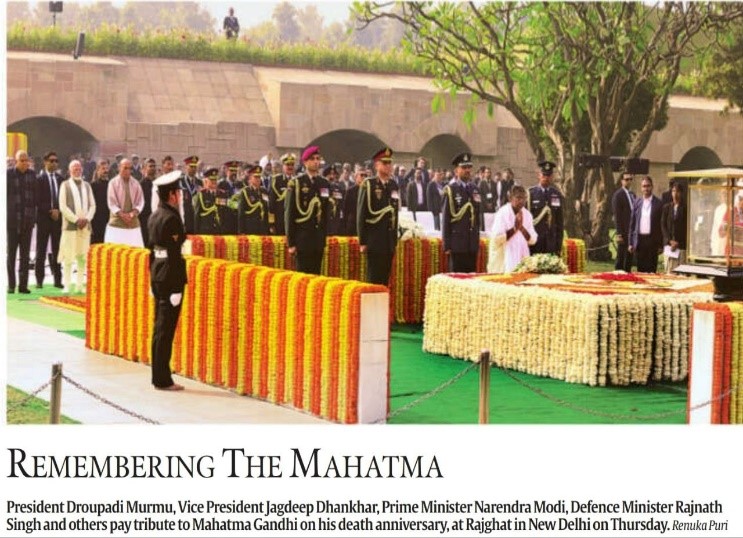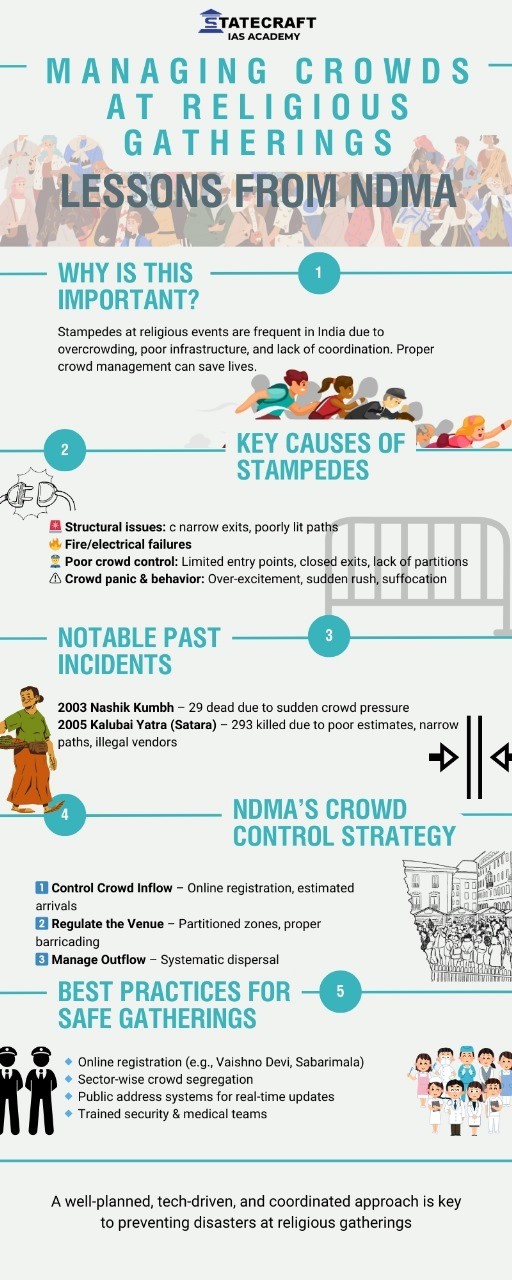Index:
- More and Better: India Needs Good Educational Infrastructure in All Districts
- IRDAI Caps Health Insurance Premium Hike for Senior Citizens
- INSV Tarini Crosses Point Nemo
- Mahatma Gandhi National Rural Employment Guarantee Scheme (MGNREGS)
- Relaxed norms on appointment of Adhoc Judges
- Other News headline
- MANAGING CROWDS AT RELIGIOUS GATHERINGS-Infografic
1. More and Better: India Needs Good Educational Infrastructure in All Districts
Key Issues
- Supreme Court Ruling on PG Medical Admission:
- No reservation based on residence for PG medical admissions.
- Aligns with the constitutional principle of equality before law.
- May impact healthcare priorities of states.
- Institutional Preference vs. Residential Requirement:
- Institutional preference (same institution admission for PG) is constitutional.
- UG medical admissions may have residential requirements to meet local healthcare needs.
- PG admissions should be merit-based to attract the best talent.
- Impact on Medical Education and Manpower Planning:
- Many states fill PG seats in government and private medical colleges with their own candidates.
- PG students form the backbone of government hospital services.
- Southern states have heavily invested in medical education and seek to prioritize local candidates.
- States may seek a review of the verdict.
- National vs. State Quota in PG Medical Courses:
- Candidates from other states can only enter PG courses through the national quota.
- States prefer local candidates for long-term medical service sustainability.
- Verdict may push the Union Government to limit states’ role in admissions further.
- Need for Decentralization in Education:
- Supreme Court distinguishes between UG and PG courses regarding local priorities.
- Raises concerns about excessive centralization of UG admissions.
- Solution lies in creating uniform educational infrastructure across districts.
2. IRDAI Caps Health Insurance Premium Hike for Senior Citizens
Key Highlights:
- The Insurance Regulatory and Development Authority of India (IRDAI) has directed insurers not to raise health insurance premiums for senior citizens by more than 10% per annum.
- Insurers cannot withdraw health insurance products for senior citizens without IRDAI’s prior approval.
- This decision aims to protect senior citizens (aged 60 and above), who are the most vulnerable to income and healthcare cost fluctuations.
Reasons Behind the Move:
- There has been a steep rise in premium rates for senior citizens.
- Medical inflation is high, and insurers cite rising healthcare costs as a reason for increased premiums.
- High hospitalization costs impact the claims outgo for insurers, as treatment expenses vary across hospitals.
Related Economic Aspects:
- The 18% GST levy on health insurance policies is also under discussion for possible reduction.
- IRDAI has urged insurers to:
- Publicize the rationale behind premium increases.
- Work towards common empanelment of hospitals and standardized treatment rates to control costs.
Significance of the Decision:
- Protects senior citizens from sudden financial burdens.
- Encourages a regulated and transparent health insurance market.
Aligns with the broader goal of making healthcare more affordable.
3. INSV Tarini Crosses Point Nemo
Context:
- INSV Tarini, a sailing vessel of the Indian Navy, is on a global circumnavigation mission under Navika Sagar Parikrama-II.
- Indian Navy officers Commander Dilna K. and Lt. Commander Roopa A. successfully navigated through Point Nemo, the most remote location on Earth.
Key Facts:
- Point Nemo:
- Located in the South Pacific Ocean.
- Known as the Oceanic Pole of Inaccessibility.
- Farthest point from any landmass (2,688 km away).
Scientific Significance:
- The officers collected vital water samples for analysis by the National Institute of Oceanography.
- Research on these samples will help understand:
- Marine biodiversity at extreme locations.
- Chemical composition of oceanic waters.
- Contributions to global oceanographic research.
Strategic and National Importance:
- Showcases India’s naval capabilities in extreme marine environments.
- Supports women officers in leadership roles in naval missions.
Enhances India’s contribution to global maritime research.
4. Maharashtra Reports New G Guillain-Barré Syndrome (GBS) Cases
Context:
- Maharashtra has reported three new cases of Guillain-Barré Syndrome (GBS) in Pune district.
- The total cases in the state have now reached 130.
- 20 patients are on ventilators, indicating severe cases.
What is Guillain-Barré Syndrome (GBS)?
- GBS is a rare neurological disorder in which the body’s immune system attacks the peripheral nerves.
- It can lead to muscle weakness, paralysis, and respiratory failure in severe cases.
- It is often triggered by viral or bacterial infections.
Possible Causes & Investigation:
- Authorities have sent water samples for chemical and biological analysis to check for any environmental factors.
- Investigations are ongoing to determine the source and cause of the outbreak.
Health & Governance Implications:
- Public Health Concern: Need for early detection and management to prevent severe complications.
- Government Response: Measures like disease surveillance, water quality checks, and medical interventions are crucial.
Healthcare Preparedness: Hospitals need to be equipped with ventilators and trained staff for GBS cases.
5. Relaxed norms on appointment of Adhoc Judges
Content.
- A Special Bench of the Supreme Court headed by Chief Justice of India Sanjiv Khanna on Thursday relaxed a condition that ad hoc judges can be appointed to State High Courts only if their judicial vacancies crossed 20% of the sanctioned
- The condition was imposed four years ago by the Supreme Court in an April 2021 judgment in the Lok Prahari versus Union of India case.
- The Special Bench, also comprising Justices R. Gavai and Surya Kant, two of the senior-most puisne judges of the top court, passed the order keeping in mind the urgent need to curb the growing case pendency.
- Article 224A of the Constitution provides for the appointment of retired High Court judges as ad hoc judges.
- Constitutional Provision: Article 224A of the Indian Constitution allows the Chief Justice of a High Court to appoint retired High Court judges to perform judicial duties, with the prior consent of the
- Criteria for Appointment: Retired judges who have previously served in any High Court can be requested for temporary judicial service if they consent to the
Who Are Ad Hoc Judges?
- Ad hoc judges are retired judges invited back temporarily to help clear backlogs of cases in High Courts. They enjoy the same powers and privileges as sitting judges but are not deemed regular
Procedure for Appointment:
- The Chief Justice of a High Court identifies potential candidates and seeks their
- The recommendation is sent to the President of India, routed through the Union Law
Ministry.
- The Supreme Court Collegium must also endorse the
- The final decision is made by the President based on advice from the Prime
Term and Conditions:
- The tenure is typically 2-3 years, depending on the
These judges are entitled to allowances determined by the President and enjoy all privileges of High Court judges during their term.





